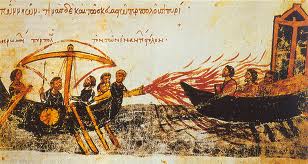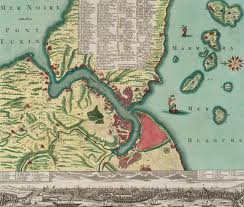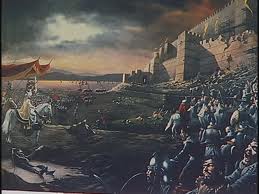|
Navy was an important aspect of Byzantine defence since the empire contained so many coastlines. At its height, the Byzantine navy consisted of some 200 ships of the line called dromons. Unfortunately, the high expense of maintaining a fleet and the rebellious nature of the sailors caused the Byzantine government to neglect the navy from time to time. Such periods of a weak navy allowed the resurgence of piracy and enemy navies, in particular those of the Arabs.

The conquest of Africa secured for Justinian the undisputed command of the Mediterranean, but he did nothing for the naval establishment. It was not till the Saracens, aspiring to conquer all the Mediterranean coastlands, became a naval power that the Roman Empire was forced, in a struggle for its being, to organize an efficient fleet.
This was the work of Constans II. In this first period (c. 650-720) the naval forces, designated as the Karabisianoi, were placed under the command of an admiral, with title of strategy. They consisted of two geographical divisions, each under a drungarios: the province of the Cibyrrhaeots which included the southern coast districts of Asia Minor, and the Aegean province, which embraced the islands and part of the west coast of Asia Minor.

The Byzantine navy, like the Byzantine Empire itself, was a continuation of the earlier Roman Empire model. In 323 AD the Emperor Constantine defeated a fleet of 350 triremes of the Eastern Emperor Licinius with a fleet of 200 liburnians, smaller and lighter than Roman triremes. In the early period by its organizational structure and technology is similar to Roman Navy.
The most important Byzantine naval ship was the Dromon, which is the ancient Greek word for runner, a light and swift boat which came in many different forms and sizes. These were galleys armed with rams as well as catapults or siphons for launching the deadly Greek Fire.

It had two or three masts, was two-decked, and could be up to 55 metres/180 feet long and 6 metres/20 feet wide. The ship was manned according to its type and dimensions. Some could carry 100, 160, 200 or even 300 men of whom some were marines (Pezonaphtes) who in battle were supported by a number of the rowers.
The Byzantine navy reached its highest point under the able sovereigns of the Macedonian dynasty (867-1056). It was divided into the imperial fleet, commanded by the Great Drungarios, the first recorded lord high admiral, and the provincial or thematic squadrons, under their strategy. Of these there were three, the Cibyrhaeotic (Cyprus and Rhodes), the Samian and the Aegean. The thematic squadrons were maintained permanently for police purposes.
IMPORTANT RANK IN THE BYZANTINE NAVY-
Commander in Chief of the Byzantine Imperial Fleet was the Emperor or Autocrator.
Chief of the Royal Fleet (Vassilikon Ploimon) was the Megas Drungarios tou Ploimou/Grand Drungarius of the Fleet, rank equivalent to the modern Fleet Admiral.
Topoteretes- Rank similar to the modern Vice-Admiral.
|

![]()


